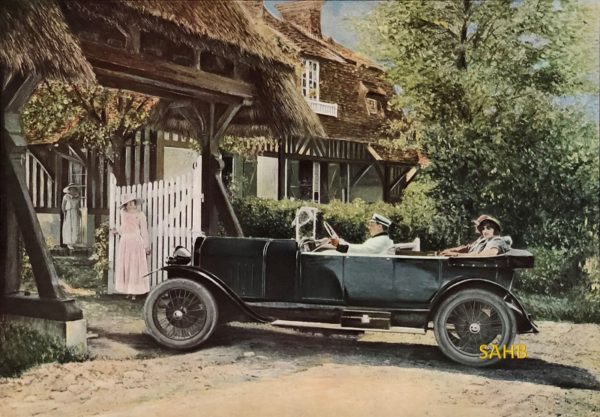
This enchanting image of a French D.F.P. has all the right credentials for a Snapshot: a quietly elegant motor car, charming ladies, a smartly liveried chauffeur and a sunny, pastoral setting sometime in 1923. The challenge is to identify the model.
In the years just before and after World War I the brothers H. M. and W. O. Bentley did much to popularise the D.F.P. in Britain. They were attracted by the tuning potential of the 1912 12/15 model, the first that Doriot, Flandrin et Parant of Courbevoie had made with their own engines. This 2-litre car, with its 4-cylinder side-valve engine, had promising ingredients: pressure lubrication, 3-bearing crankshaft and 4-speed gearbox. Bentley worked his magic on a standard two-seater and took it to the Aston hillclimb; he won his class; on Formula he won the event outright. He is credited with being one of the first to use aluminium alloy pistons. He realised that they would dissipate heat better than those made of the conventional cast iron, that they would be lighter, and that therefore they would permit higher engine speeds and thus yield more power. He proved this by breaking records at Brooklands in 1914 in a car fitted with these pistons, a special camshaft, lightened con rods, and improved inlet manifolding.
Bentley persuaded D.F.P. to fit the pistons to production cars, and thus was created the 12/40. Sadly, few were made before World War I intervened. Bentley ‘went to war’, designing his highly effective BR1 and BR2 rotary engines to power British fighter planes.
When the Armistice was declared W.O. was fully engaged in the development of his own car, but until the 3-litre was ready Bentley & Bentley continued to sell the 12/40, little modified from its pre-war specification.
By 1920 the Bentley was ready, and the British agency for D.F.P. passed to Ward & Driskell. Back at the factory, the tuned, lively D.F.P. engines were replaced by proprietary units bought in from Altos and Sargant. The loss of Bentley & Bentley’s vigorous promotion of the cars in Britain, DFP’s biggest market, and the backward move in technical specification, together started the decline of the company.
So which model does our Snapshot show? Reliable details are scarce, but the clues may lie in the caption to this delightful picture: “Doriot Flandrin-Parant – La 12 CV châssis bloc D.F.P.” The words “Bloc D.F.P.” almost certainly mean that the engine block was made by the company and not by Altos or Sargant. D.F.P. did in 1923 start to make their own engines again, but their 12 CV was made from 1919 to 1922 and is said to have an Altos 2-litre engine. This car may therefore be the Series A.D.M Type “13/50” with a 1994cc ohv D.F.P. engine, introduced in 1923. The 13/50 designation could well be British: French taxable horsepower or CV is usually lower than the equivalent in Britain.
Georgano states that the 13/50 engine had the same dimensions as the Altos and so could be an overhead valve conversion by D.F.P. of the Altos engine. But then why does the caption specifically mention that the block is by D.F.P.? We would love to hear from people more knowledgeable than us, but for now we are plumping for a 13/50.
As for the fate of the company, in 1922 they introduced a lively little light car, the D.F. Petite, with a 1098cc ohv C.I.M.E. engine; it was sold in Britain from 1923. In 1926, however, all production ceased and the factory was bought by the makers of the Lafitte light car.
Picture courtesy of the Richard Roberts Archive







Leave a Comment